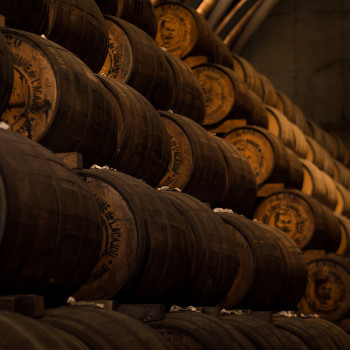COOPERAGE


A cooperage provides services for the whisky and spirit industry:
- coopering casks;
- toasting or charring the interiors of casks;
- repairing casks;
- upsizing or downsizing casks;
- sourcing particular casks for distilleries.
Few of the big whisky companies have in-house cooperages: Diageo and Loch Lomond in Scotland, Suntory in Japan.
Between the independent cooperages around the world, we find Humberto Domecq and Tonelería Tevasa in Spain, and Thorslund in Sweden. In Scotland, Speyside Cooperage has two locations: Craigellachie and Alloa.
Part of the job for production coopers is to resize casks, upward or downward, but most importantly to repair casks: a cask of 30-32 staves is normally considered repairable if it has up to 15 broken staves; if there’s more than 15, it becomes a “donor cask” and its undamaged staves are used to repair other casks.

Becoming a cooper starts with an apprenticeship, which duration may vary depending on the country.
In Scotland apprenticeship for coopers takes four years.
The first two years of apprenticeship students learn how to use traditional tools and acquire important notions like how wood reacts to wet and dry conditions or how the cask behaves during its stay at warehouses.
In third year apprentices coopers are introduced to working on the shop floor, and in year four they begin working shifts side by side with qualified coopers.
As the apprenticeship is more hand work than study modules, the cooperage work is very physical.
Much of the heavier work is done by hydraulic presses, fork-lift trucks and other special machinery, which allows coopers to concentrate on other finer aspects of their job.
There are no regulations saying what the minimum cask size must be, and it’s up to coopers to produce a cask following the distillery’s requirements.
A cooper may realise and repair casks for whisky ageing and finishing with very different sizes:
- small casks with a capacity of 5 or 10 litres;
- firkin, a traditional cask used in Scotland, with a capacity of 40 litres;
- octave, a less used traditional cask for Scottish whisky, with a capacity of 50-55 litres;
- quarter, a 125 litres cask, used for finishing;
- 200 litres Bourbon barrel, very popular in Scotland;
- wine barriques, used to age red and white wine in various countries before hosting malt whisky, with a capacity of 200-225 litres;
- hogshead, a sherry casks of 250 litres;
- butt, also a sherry casks, but with a capacity of 500 litres;
- puncheon, as capacious as a butt, but shorter and rounder;
- barrique Port casks (225 litres) and Port pipes (500-600 litres);
- the biggest cask ever used, 700 litres of capacity, used for Scotch whisky, Irish whisky, EU and Australian whisky.
Between these cask sizes, puncheon is very interesting for coopers, as it is a result of practicality.
Sawing logs to make butt casks requires a stave length of 1.4m, but flaws in the timber can happen and a crack or a knot can prevent the construction. If a flaw leaves at least 1.2-1.3m of oak though, this can be used for a puncheon, reducing waste at minimum.

Source: The Whisky Dictionary: an A-Z of Whisky, from history & heritage to-distilling & drinking




